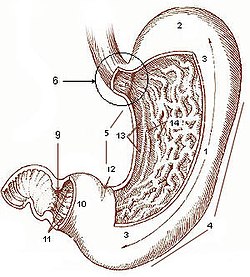|
Rugae
 In anatomy, rugae (sg.: ruga) are a series of ridges produced by folding of the wall of an organ.[1] In general, rugae are a biological feature found in many organisms, serving purposes such as increasing surface area, flexibility, or structural support. Most commonly rugae refers to the gastric rugae of the internal surface of the stomach. For terrestrial gastropods, the rugae often appear as fine, transverse folds or wrinkles on the mantle, back, or sides of the body. They are particularly visible when the animal extends its body or contracts, and may also be interrupted or intersected by other grooves or structures (such as dorsal grooves or keels) . FunctionA purpose of the gastric rugae is to allow for expansion of the stomach after the consumption of foods and liquids. This expansion increases the volume of the stomach to hold larger amounts of food. The folds also result in greater surface area, allowing the stomach to absorb nutrients more quickly. LocationRugae can appear in the following locations in humans:
Difference between rugae and plicaeWith few exceptions (e.g. the scrotum), rugae are only evident when an organ or tissue is deflated or relaxed. For example, rugae are evident within the stomach when it is deflated. However, when the stomach distends, the rugae unfold to allow for the increase in volume. On the other hand, plicae remain folded regardless of distension as is evident within the plicae of the small intestine walls. References
|
||||||

